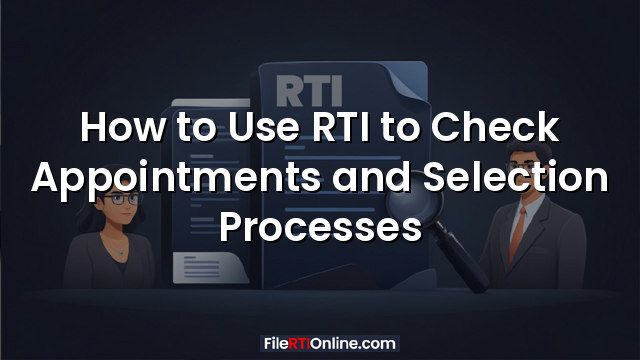Understanding Recruitment Transparency Through the Right to Information Act
Public appointments — whether for government officers, regulatory authorities, commissions, tribunals, or other statutory bodies — have a direct impact on governance. Citizens are increasingly using the Right to Information (RTI) Act to ensure that such appointments are fair, transparent, and free from arbitrariness.
This guide explains how to effectively use the RTI Act to check appointments, selections, nominations, and promotions in government bodies. It also includes insights derived from actual Central Information Commission (CIC) cases.
Why Use RTI to Check Appointment and Selection Processes?
RTI helps citizens:
- Understand whether the selection process followed the rules.
- Verify if eligible candidates were considered.
- Check if any improper or arbitrary decisions were taken.
- Identify whether any conflict of interest existed.
- Monitor transparency in high-level appointments such as Information Commissioners, regulatory board members, and other officials.
Even when full information cannot be disclosed due to legal exemptions, RTI often reveals crucial procedural details.
1. What Information Can You Seek Through RTI?
Under RTI, you can ask for any recorded information, such as:
● Advertisement and Notification Details
- Vacancy notification
- Eligibility criteria
- Reservation details
- Application deadlines
- Number of applicants
● List of Candidates Considered
- Names of candidates shortlisted
- Names recommended
- Names rejected
- Criteria used for ranking or shortlisting
● Selection Committee or Panel Details
- Composition of the selection committee
- Date and venue of meetings
- Minutes of meetings (unless exempt)
- Recommendations made committee
● File Notings and Internal Correspondence
- Notes justifying the choice of selected candidates
- Reasons for rejecting other candidates
- Process followed for verification and scrutiny
● Applicable Rules and Guidelines
- Recruitment rules
- Appointment procedures
- Evaluation norms
- Departmental manuals or office orders
● Status of a Complaint or Representation
- Whether a grievance about the appointment has been examined
- Action taken on a complaint
2. What Information Cannot Be Obtained?
Certain information may be exempt under Section 8 of the RTI Act:
● Personal information
Personal details of candidates (Section 8(1)(j)), unless there is overriding public interest.
● Confidential assessments
Confidential reports, internal evaluations, or interview marks may be withheld if it harms public interest or violates privacy.
● Commercial or competitive information
In certain statutory appointments where third-party confidentiality is involved (Section 8(1)(d)).
● Matters under active judicial consideration
If a court has restricted disclosure.
● Records not maintained
PIOs cannot create information, justify decisions, or answer hypothetical questions.
3. Model RTI Questions for Checking Appointments
Use specific, document-based queries. For example:
- Provide a copy of the recruitment/appointment rules for the post of _________.
- Provide a copy of the vacancy circular/notification issued for the said post.
- Provide a list of all applicants who applied for the post.
- Provide a list of shortlisted candidates and criteria for shortlisting.
- Provide minutes of the Selection Committee meeting held on ________.
- Provide file notings related to the selection/appointment of _________.
- Provide a copy of the recommendation submitted to the competent authority.
- Provide reasons recorded (if any) for rejection of other candidates.
- Provide the procedure followed for including the name of ________ in the shortlist.
- Provide a certified copy of the final appointment order.
These questions ensure you receive structured, recorded information.
4. What Happens If Information Is Denied?
If the PIO denies information:
Step 1: File a First Appeal (FAA)
- File within 30 days.
- Clearly state why the denial is incorrect.
- Cite relevant RTI provisions.
Step 2: File a Second Appeal or Complaint to CIC/SIC
If the first appeal is not satisfactory, approach the Information Commission.
Common grounds for CIC intervention include:
- Unreasonable denial of file notings
- Wrong use of exemptions
- Non-availability of reasons for including/excluding candidates
- Failure to disclose recruitment rules
- Incomplete or misleading information
- Delay in providing information
CIC often orders disclosure of non-exempt documents and can impose penalties on PIOs for delay or misconduct.
5. Key CIC Case Insights on Appointments
Case Example 1: Appointment of Information Commissioners
The CIC held that:
- The RTI Act does not prescribe a detailed appointment procedure.
- No central government rules exist specifying the method.
- PIOs cannot speculate on why certain names appear in lists.
- Only recorded documents can be shared.
Takeaway: RTI can reveal the lists and file notings, but not hypothetical explanations.
Case Example 2: Third-Party Personal Information in Appointments
Disclosure of personal information of candidates may be denied unless larger public interest is established.
Takeaway: Seek procedural records, not personal details.
Case Example 3: CIC Directions in Cases of Non-Disclosure
CIC has imposed penalties on PIOs for withholding or delaying recruitment-related information.
Takeaway: PIOs are accountable for proper disclosure.
6. Tips for Drafting Effective RTI Applications on Appointments
- Ask for documents, not explanations.
- Reference specific dates, notifications, or file numbers if possible.
- Avoid vague or opinion-based questions.
- Use procedural questions — they have the highest chance of success.
- If seeking third-party details, justify public interest.
- If appointment is to a high office affecting public life, state the public interest explicitly.
7. Final Checklist Before Filing Your RTI
- Identify the exact authority responsible.
- Check whether the appointment is statutory, contractual, or administrative.
- Use precise, point-wise questions.
- Keep a record of your RTI and tracking number.
- Follow up with appeals, if necessary.
Conclusion
RTI is a powerful tool to ensure transparency in the appointment and selection of government officials. While some information may be exempt, a well-structured RTI application can reveal:
- Whether proper procedures were followed,
- Whether eligible candidates were considered,
- Whether recommendations were made fairly, and
- Whether the selection was done according to rules.
Citizens can use RTI to promote accountability, discourage arbitrary decisions, and strengthen trust in public institutions.


